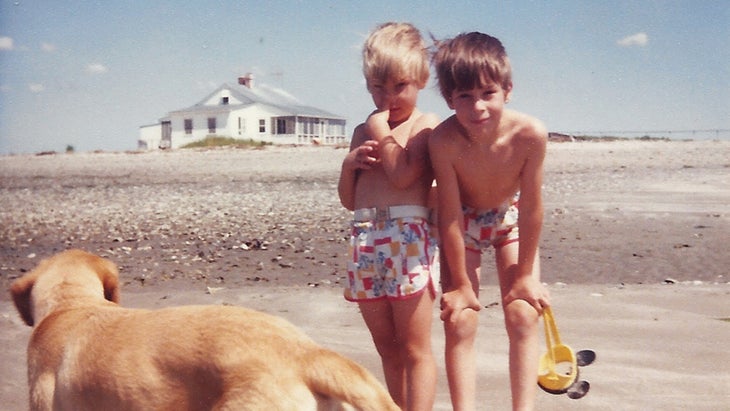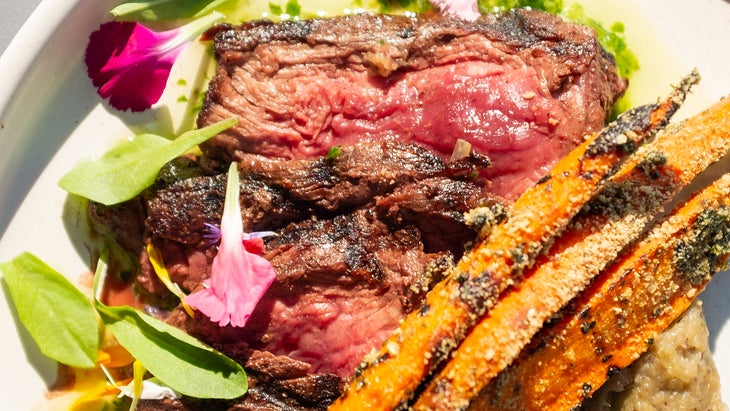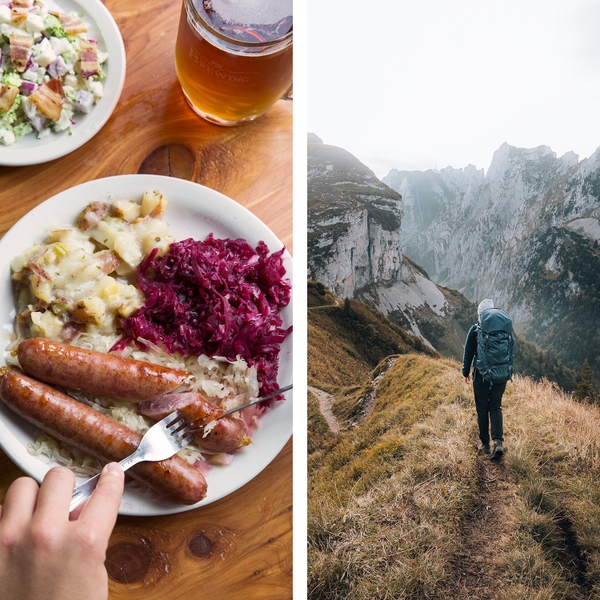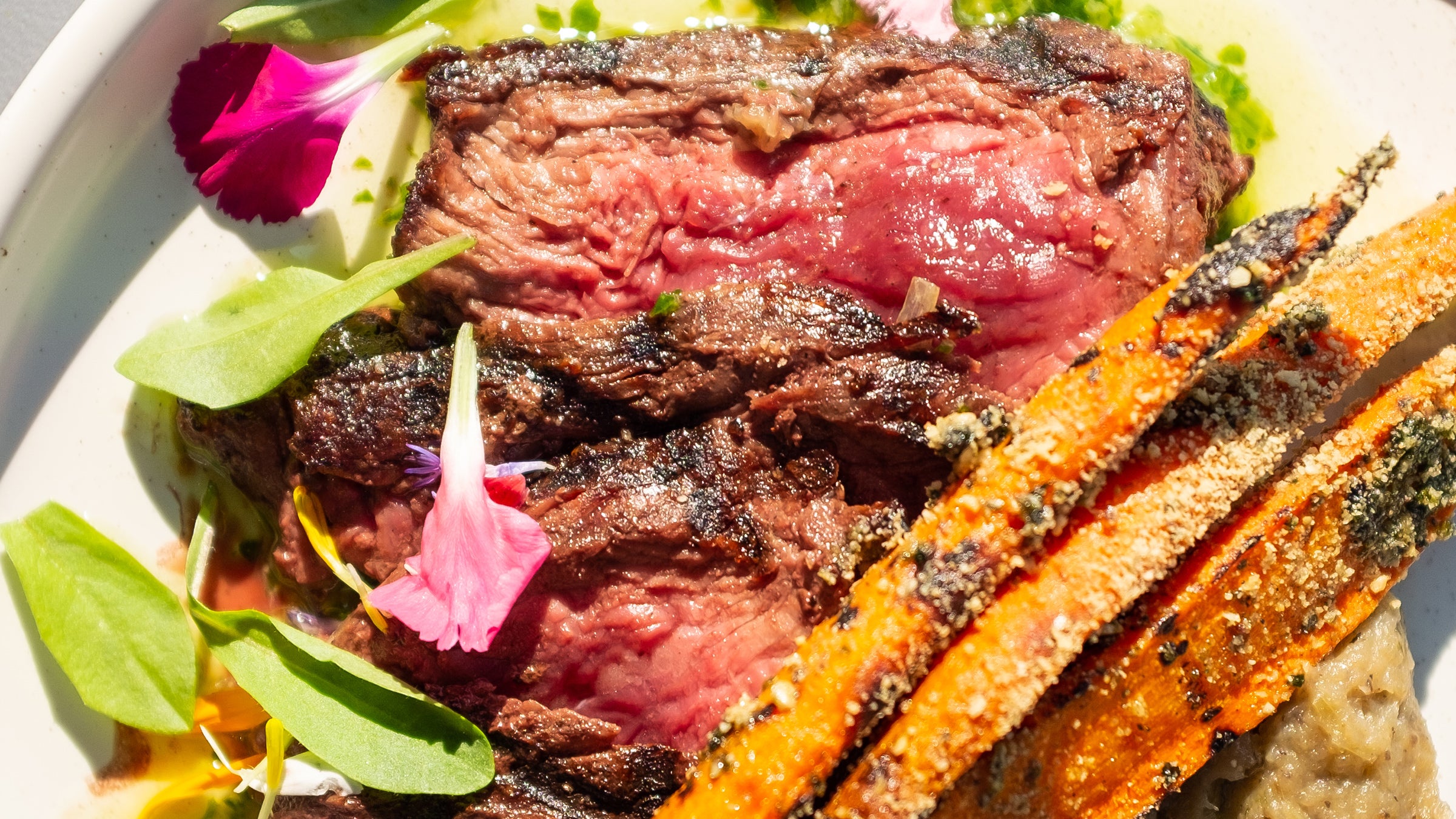These 8 Meals Are Worth Traveling For
Tim Neville has been around the world and back again, and as good travelers do, he’s made sure to try the local cuisine at every stop. So we asked him to write about his favorite meals—and how you can try them, too.
New perk: Easily find new routes and hidden gems, upcoming running events, and more near you. Your weekly Local Running Newsletter has everything you need to lace up! .
In the late 1970s, my parents took my brother and me to a cabin on Little Cobb Island, an uninhabited dollop of beach and seashells on the Atlantic side of Virginia’s Eastern Shore. The cabin was only accessible by boat, and things could get sketchy if the fog rolled in and you drifted too close to the surf. It was November, and the lodge was cold and drafty, so all four of us slept that first night stacked like cordwood in a single musty bed.
I was only four or five years old, but four decades later I can still recall with full clarity the smell when I woke up the next morning. Bud Taylor, a local roofer who doubled as the cabin’s caretaker, was cooking sausage in a cast-iron pan atop a stove fired by driftwood. “Here, boy,” my father said, handing me a link. It was small and gray and wet with fat. Every bite sent delicious bolts of grease sizzling around my scrawny body. “Everything tastes better when you’re roughing it,” my father said, sensing my astonishment and handing me another link. “Don’t eat ’em all.”

Our Travel Writer’s Favorite Après ���ϳԹ��� Food
From kimchis in South Korea to falafels in Egypt, our author says these meals refueled him after adventures on the roadThere was nothing even remotely special about that sausage. It was just a pack of Jimmy Dean that Bud had picked up at the local Meatland market before we launched from the town of Oyster. But consuming those lumpy treasures out there, with the wind bullying the windows and the tide marching in, had transformed every single bite into a culinary masterpiece.
That’s the beauty of food and adventure, that something as simple as saucy grits can be downright magical on Oregon’s John Day River. Lentils at home are just wrong—convince me otherwise—but when spooned over rice in a remote Nepalese teahouse, with the Himalayas shimmering in the purple moonlight, you’ll be crying for more, too.
Food has given me so many great reasons to travel, to be curious, to try something new. I spent the bulk of a Swiss vacation hunting for a particular cheese, learned to make pickles from an Estonian lady who exacted her payment in kisses, delighted a friend by picking her pomegranates while hiking in Albania, and gave my tongue a fungus eating so many fermented things on a ski trip to South Korea. One great bite can change your entire perception of a place. If you want to fall in love with North Dakota, go run through the grasslands with a bag of Dot’s pretzel sticks.
That’s what I did. And of course I ate ’em all. Here are some of my other favorite meals from around the world.
Brats and Bikes: Hermann, Missouri
Back in the early 19th century, German immigrants left their homes in Philadelphia and set out west looking for land to build their own community. They settled along the Missouri River, where the hills and sunshine reminded them of the Rhineland, and the town of Hermann was born. Today you’ll still find families named Oelschaelger, streets like Goethe and Gutenberg, and, of course, heaps of wunderbar food and drink. Biking is one of the best ways to experience that legacy, too. The Katy Trail runs for 240 carless miles over rolling hills between Clinton and Machens and is the country’s longest rail-to-trail path. You will spin over mostly limestone gravel through farmland and along the Missouri River, then past wineries and into small towns like Rocheport, where the welcomes diners and riders alike with a fleet of rentals, and Hermann, a town worthy of a layover. Start things off at the on East First Street, where wurstmeister Mike Sloan peddles classics like knockwurst, weisswurst, and bockwurst, as well as creative, American-influenced versions like the Bloody Mary brat, a hickory-smoked iteration with celery, tomato, and horseradish. You won’t go thirsty, either. The whole riverfront region between Saint Louis and Jefferson City is known as the Missouri Rhineland for its scores of wineries. Hermann’s own Stone Hill is also home to the restaurant Vintage 1847, serving various wursts, krauts, and kartoffelpuffer, a potato pancake that’s a delight to say as well as eat. Forty miles east, the area around Augusta became America’s first federally recognized wine region in 1980, beating California’s Napa Valley by eight months. At the end of the line—or anywhere along it, for that matter—getting back is easy. Amtrak trains zip along the opposite bank, with special cars that can accommodate your bike.
Fondue Redux: Obwalden, Switzerland
It doesn’t take a culinary Sherlock to figure out what happens when a country famous for cheese shares a border with one famous for pasta—you get world-beating mac and cheese. And the Swiss version is excuse enough for an ocean crossing. Called ä�����������������DzԱ��, or herdsman macaroni, it’s richer and smokier than the American stuff, made with bacon, butter, wine, and supremely stinky cheese melted in pools of heavy cream in a cast-iron cauldron over an open fire. Pour it over macaroni or penne and the result is exactly what you want after a long day in the Alps. You can find this dish throughout the country, but for the most authentic experience head to the central canton of Obwalden, where several small mountain farms double as restaurants come summer. Once, while cycling over the 5,285-foot Glaubenbielen Pass, I happened upon one where the matriarch, a boisterous woman named Rita Enz, served me a mound with a side of applesauce and stiff stone-fruit brandy. The Enzes have since retired, but their farm was located along the Ä�����������������DzԱ�� Trail, which lives on today. Its little-known network of well-marked footpaths and dirt roads lead to a handful of farms that create the namesake dish using ingredients produced on-site. To explore, keep your objective simple, with a two-mile out-and-back hike along the Obwaldner Höhenweg Trail, starting from a parking area just west of Glaubenbielen Pass; you can stop at the Glaubenbielen Alpine Farm, near the 5,860-foot Rotspitz, or wander a few miles west to the Alp Arni-Schwand farm. For an overnight trip, hike about 4.5 miles one way south on the Bärgmandlipfad Giswil Trail, also called Trail 576, to reach the Fluonalp farm, where the dairy cranks out 29,000 pounds of cheese each summer, some of which ends up in ä�����������������DzԱ��. You can stay there, too (from $70).
Food Finds
Camp Chef
Three outdoor schools take backcountry cooking to a whole new level
Want to blow your friends away with a hearty stew or a freshly baked pie on your next river trip? The near Philipsburg, Montana, offers a four-day class that will see you mastering the art of Dutch-oven cooking (from $800). Or learn to barbecue better with four-time world-champion pitmaster and bestselling cookbook author Myron Mixon, whose in Unadilla, Georgia, will bolster your confidence preparing everything from pork butts and shoulders to chicken, beef, and ribs (you know, all the food groups) during a three-day course at his home (from $895). And if you’ve simply got to perfect pasta, Italy’s Emilia-Romagna region is the premier place to start. Make it a weeklong adventure with a van-supported, 156-mile bike tour from Parma to Bologna with (from $1,500). You’ll stop in towns along the way for tutorials on balsamic vinegar, gelato, and, naturalmente, handmade pasta.
Breakfast Club: Lone Pine, California
Last summer, photographers Dan and Janine Patitucci spent months mapping remote trails in California’s Sierra Nevada, looking for the best 36 paths to highlight in a new trail-running guidebook, to be published later this year. Their most rewarding discovery? Breakfast at the . And by breakfast we mean pie. The diner has perfected the art of the light, flaky crust, and it loads them up with the freshest fruit available. The triple-berry pie sells out fast, but the Patituccis also recommend the peach and blackberry, which you can order in a six-inch round just for yourself. The café is located just 12 miles from Whitney Portal, the jumping-off point for climbing (or running) 14,494-foot Mount Whitney, the highest point in the lower 48. It’s also about 120 miles from Badwater Basin in Death Valley National Park, at 282 feet below sea level the country’s lowest point. Summiting Whitney is a big day by any measure, with about 21 miles and 6,600 vertical feet to cover. If that’s your goal, order the Iron Man Scramble—an eggy hodgepodge of spinach, avocado, mushrooms, and tomato slathered in hollandaise sauce—and get your pie to go. If you’re spending the night, grab a slice in the morning.
First-Reds Frenzy: Cordova, Alaska
Each spring, a craze begins to cloud the minds of Alaskans, and it has nothing to do with the approach of summer and, with it, of long stretches of actual daylight. Spring is when the first Copper River reds, a highly coveted and especially tasty sockeye salmon, begin arriving on the docks of Cordova, located at the mouth of the river, about 145 miles southeast of Anchorage. The fish, which can easily go for $50 a pound, are prized by chefs for the additional fat they pack on to complete their 300-mile journey, which makes for richer and more decadent eating. While you could order a fillet from Sarah Ecolano, a commercial fisherwoman and founder of the sustainable , why not head deep into the Last Frontier to witness the madness firsthand? First book a room in Cordova at the (from $140) overlooking the inlet, then set out on any of the 40 streams and rivers guides have access to. You can sportfish for salmon in the salt water, or head up to the Eyak River to throw big streamer flies at reds and Dolly Varden trout. At the end of your trip, the lodge will process up to 50 pounds of fish per person per day at no additional charge, flash freeze it, and store it for you until you’re ready to head home.
Food Finds
Hunt, Gather, Eat
A series of courses teach the value—and ethics—of holistic harvesting
You’ve probably heard that one of the best things you can do for the planet is give up meat, but that kind of misses the point. It’s not the burger that’s the bogeyman but the industrial, methane-spewing, water-polluting complex behind mass-produced meat. Enter Bruce McGlenn and his . Based in Kettle Falls, Washington, McGlenn teaches students who have never held a rifle or harvested a wild oyster how to hunt and gather. “Hunting is really about strengthening our connection to nature so that we feel we’re a part of it,” he says. “It’s about being human.” From May through June, McGlenn holds a series of four-day Awaken the Hunter courses, designed to brief you on how to prepare for and carry out a “holistic, ethical hunt.” It covers everything from regulations and strategy to choosing the right rifle or bow. In the field, you’ll learn how to dress and butcher your kill, as well as proper ways to cook it. McGlenn also offers half-day shellfish-foraging lessons on Hood Canal, where you’ll learn how to identify Manila clams and shuck a wild oyster. The session ends with a three-course feast right on the beach. Foraging from $195; hunting from $2,400 for four days
Eater on Belay: Kalymnos, Greece
The Greek island of Kalymnos sits just off the coast of Turkey, about 150 miles southeast of Athens, and counts as the closest thing to Elysium on earth. Whitewashed villages ring a ragged coast of limestone cliffs facing the Sea of Crete. While climbers know this 42-square-mile paradise for its thousands of sport routes, which ascend spectacular sun-fired arches and walls, you should come to meet George Pizanias, quite possibly the island’s best cook, judging by the crowds that flock to his restaurant, the , in the town of Massouri. Pizanias runs the establishment with his wife and three daughters, and prepares traditional Greek recipes with “an extra touch,” as he says, like adding homemade fruit chutneys that set the meal apart. Grab a table on the patio that overlooks the island of Telendos and let gluttony rule. Should you start with the stuffed grape leaves or the “ancient” salad? (The latter is a mix of wild vegetables the islanders have been eating for millennia, something Pizanias’s culinary research uncovered.) The whole leg of lamb, roasted to perfection, is hard to pass up, but it’s the tuna that’s exceptional; caught that day, it’s pan-seared with sesame seeds and served with marinated beets, red cabbage, olive oil, lemon, and fig chutney. If that doesn’t seal the deal, dessert probably will. Pizanias makes his own ice cream and serves it atop little fried dough balls called loukoumades, which he then drizzles with Kalymnos’s most famous ingredient: a golden, naturally herbal-tasting honey made by bees drawn to the island’s large swaths of wild thyme and oregano. Try not to think about that when it’s your turn to belay.
The Meat and Three: From Oxford to Hattiesburg, Mississippi
Chef Robert St. John knows a thing or two about awesome southern food. As the author of 11 cookbooks, the owner of seven restaurants, and the producer of the foodie show , the 60-year-old from Mississippi has spent a lifetime refining family recipes that have defined the region for centuries: Fried chicken. Dumplings. Black-eyed peas. For him, the greatest way to experience the South is to taste it, and to do that, he suggests a 250-mile road trip from Oxford in the north down to Hattiesburg via the capital city of Jackson. The itinerary links some of the most memorable community cafés in the state offering the traditional “meat and three” lunch special: a choice of protein with three sides, like collard greens, butter beans, and rice with gravy. The main at in Oxford is southern-fried catfish, while Bully’s in Jackson does everything from pigs’ feet to beef tips, all served on a wonderfully lowbrow cafeteria tray. The highlight might be the in Hattiesburg, run by St. John. “Best fried chicken of your life,” he says. Bring a paddleboard or a kayak to explore the northern recreational playgrounds of Grenada Lake and Sardis Lake, the latter also popular with mountain bikers, who enjoy 13.5 miles of singletrack at Clear Creek. End your trip in the Gulf town of Biloxi; from there you can quickly paddle to Deer Island Coastal Preserve, a four-mile undeveloped stretch of white sand where you can pitch a tent for free.
Food Finds

Back to Their Roots
A new Minneapolis restaurant is serving up gourmet Native American cuisine
There’s a growing movement of Native American chefs exploring their traditional food cultures, and it’s only getting tastier. In July, Sean Sherman, better known as the and lauded for his bestselling cookbooks, and Dana Thompson, executive director of the , opened , a restaurant in downtown Minneapolis on the banks of the Haha Wakpa, or Mississippi River, that’s dedicated to Native cuisine. You’ll find no dairy, chicken, or pork on the menu—or any other ingredients that aren’t indigenous to North America. Instead, chefs whip up delectables like native-corn tacos with grilled mushrooms, bowls of tepary beans with wild rice and wojape (a chokecherry sauce), and plates of braised bison. Even the cricket salad looks irresistible.
Big Sky, Big Steak: Hatch, Utah
If you could survey the legions of visitors who come to southern Utah every year to explore the national parks and monuments that pepper this beautiful part of the country, chances are good they would say these three things impressed them most: the rocks, the sky, and the steak in Hatch. Tucked in a rather boring brown building in this dusty hamlet, a mere 15 miles from the gates of Bryce Canyon, the on Main Street is an institution worthy of your attention. It’s a classic western joint, with a taxidermied bear on its stage and a bar where passersby can belly up for a spiked sarsaparilla on an actual saddle for a seat. But it’s the giant, open-flame grill in the room that makes this place unique. That’s where you go to cook your own steak. This is cattle country, and the beef is as good as you’d expect—local, grass-fed, mouthwatering cuts. Most folks aren’t from around these parts, so they opt for something hard to mess up like a New York strip. The more dedicated, however, should set their sights on the Tomahawk, a 24-ounce rib eye that covers the entire plate. The grill has meat probes to help you get that perfectly pink middle, or you can spend an extra three dollars to have the staff grill it up for you. If steak isn’t your thing, the chef smokes a batch of baby back ribs daily with hickory and other hardwoods until the meat falls off the bone. Also, sorry, families; no one under 21 is allowed inside, because Utah. As for working all those calories off, it just so happens that the nation’s newest long-distance hut-to-hut mountain-bike route runs right past the saloon. The Aquarius Trail stretches for 190 miles from Brian Head to Escalante and includes rollicking descents on solid singletrack like the 12-mile Bunker Creek Trail, which you’ll ride on day one into Hatch; from there, the first hut is just a few merciful miles away.












